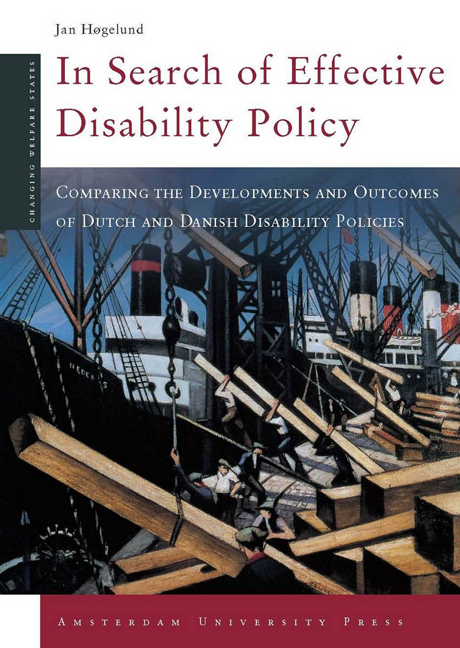 In Search of Effective Disability Policy
In Search of Effective Disability Policy Book contents
- Frontmatter
- Contents
- Acknowledgement
- 1 Disability Policies Under Pressure
- 2 The Integration of Disabled People:What Do We Know?
- 3 Bringing the Pieces Together:A Multidisciplinary Approach to Work Disability
- 4 Economic Miracles Bypassing Disabled People
- 5 Dutch Disability Reforms:Redefining Responsibilities
- 6 Danish Disability Policy:Small Steps,Big Change?
- 7 Different Routes to Integration
- 8 Different Policies – Different Outcomes
- 9 Too Much and Too Little:Employers’Responsibility in Denmark and the Netherlands
- Tables and Figures
- Notes
- References
- Index of Subjects
- Index of Names
9 - Too Much and Too Little:Employers’Responsibility in Denmark and the Netherlands
Published online by Cambridge University Press: 15 January 2021
- Frontmatter
- Contents
- Acknowledgement
- 1 Disability Policies Under Pressure
- 2 The Integration of Disabled People:What Do We Know?
- 3 Bringing the Pieces Together:A Multidisciplinary Approach to Work Disability
- 4 Economic Miracles Bypassing Disabled People
- 5 Dutch Disability Reforms:Redefining Responsibilities
- 6 Danish Disability Policy:Small Steps,Big Change?
- 7 Different Routes to Integration
- 8 Different Policies – Different Outcomes
- 9 Too Much and Too Little:Employers’Responsibility in Denmark and the Netherlands
- Tables and Figures
- Notes
- References
- Index of Subjects
- Index of Names
Summary
The Dutch and the Danish disability policies share the aim of reducing the number of people entering the disability benefit rolls while increasing the labour market attachment of people with health problems. Yet we have seen that during the 1990s different policies were enacted in order to reach these goals, and that these policies result in very different outcomes.
The Dutch policy focuses on employers who to a large extent have become responsible for the financing of sickness and disability benefits and the reintegration of disabled people; employers have been given strong economic incentives to retain workers after the onset of a disability. While this policy results in the work retention of long-term sick-listed workers, it apparently suffers from high numbers of long-term sick-listed people and the problems of integrating disabled people with no or limited prior attachment to the labour market.
In contrast, the Danish policy emphasises public responsibility for the provision of social security benefits and integration of work-disabled people. The means to obtain integration and limit the load on the disability pathway is related to a policy that induces public authorities to apply active instruments rather than passive benefit awards. This policy does not encourage reintegration of long-term sick-listed workers, who in spite of publicly provided capacity-building measures have difficulties in returning to work. But in contrast to the Dutch policy, the Danish policy nevertheless seems to limit long-term absenteeism, and it apparently does not increase insider/outsider problems.
The Dutch and Danish policies seem to be associated with different strengths and weaknesses that make it difficult to provide an overall ranking of the two policies. This chapter therefore looks at the Dutch and Danish policies from another angle, and asks whether the policy changes during the 1990s succeeded in reaching the goal of limiting the load on the disability benefit schemes. I first set out by looking at the size of the pressures on the Dutch and Danish disability benefit schemes during the 1990s, arguing that even though the Dutch disability problems seem much worse than those in Denmark they are not. I then discuss whether the policy changes during the 1990s succeeded in limiting the load on the disability benefit schemes.
- Type
- Chapter
- Information
- In Search of Effective Disability PolicyComparing the Developments and Outcomes of the Dutch and Danish Disability Policies, pp. 159 - 178Publisher: Amsterdam University PressPrint publication year: 2003


